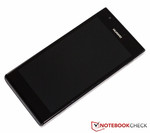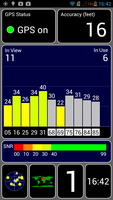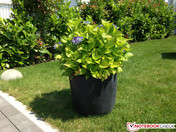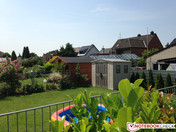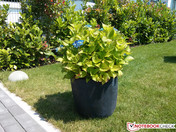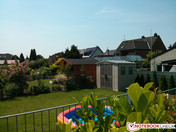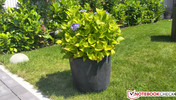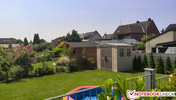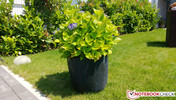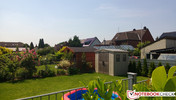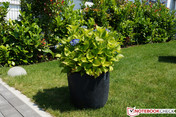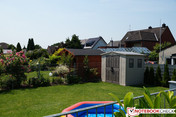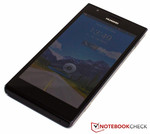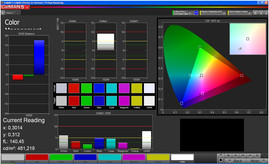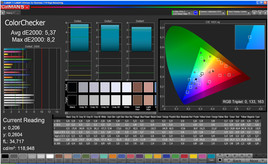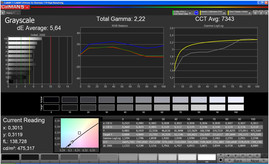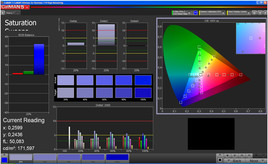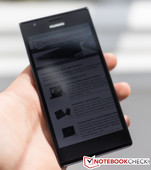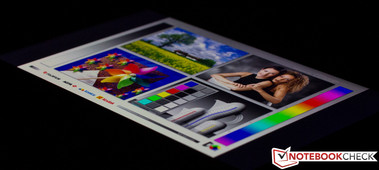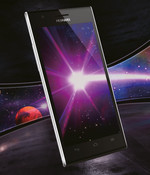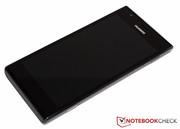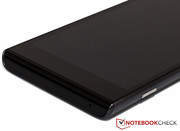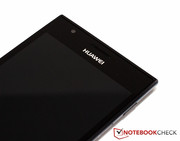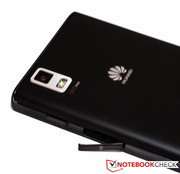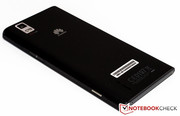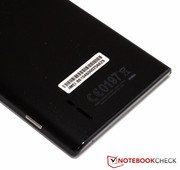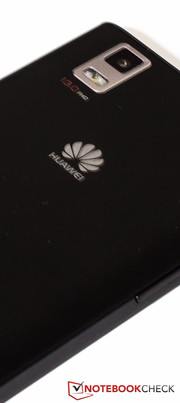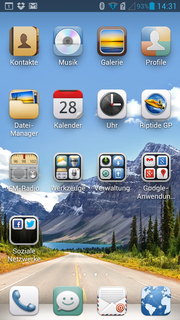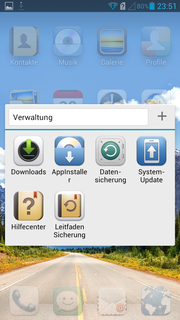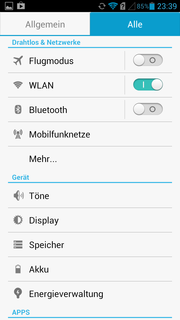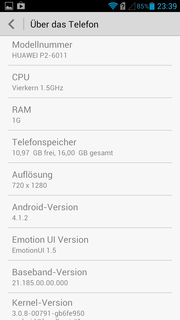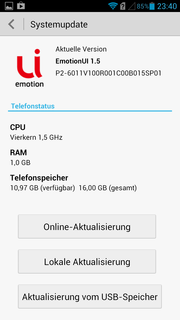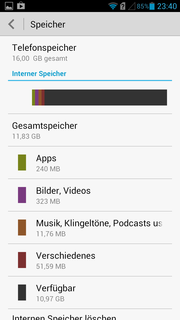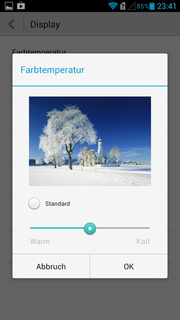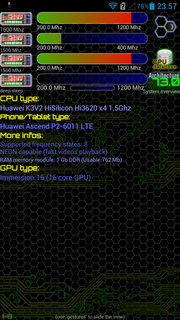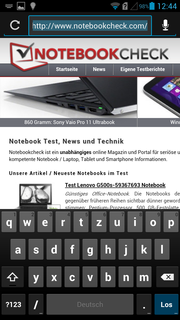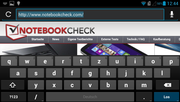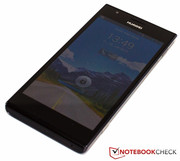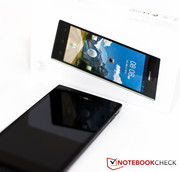Review Huawei Ascend P2 Smartphone
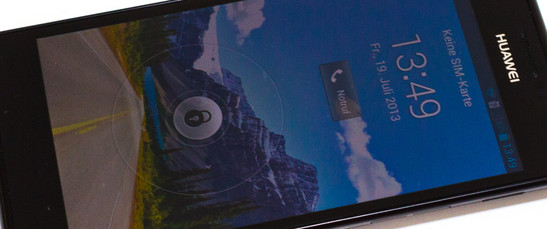
For the original German review, see here.
The major Chinese corporation Huawei touts its 4.7-inch smartphone with the slogan: "The world's fastest 4G LTE Smartphone". The manufacturer aims high with that and we will uncover whether it might just be too high in this test report.
With a 1.5 GHz quad-core SoC from the company's own product line and a 16-core GPU, the device places itself in the vicinity of premium smartphones, such as HTC's One, the Galaxy S4 or Nexus 4. However, the Ascend P2's much lower working memory capacity cannot compete with that of the "big" ones. Its HD resolution of 1280x720 pixels is contemporary but not exceptional. Nevertheless, we will as always take an unbiased approach in this test and give the LTE smartphone the same opportunities as the competing models.
Case
The non-removable back cover of the Ascend P2 is comprised of roughened matte black plastic. The display bezel is also black but the polycarbonate has been polished to a piano finish. The build makes a high-quality impression not least because the gaps look fairly equal. The casing is very resistant against selective pressure and mostly rigid. The device's weight of 122 grams is lighter than the Galaxy S4 (130 grams) and HTC's One (143 grams). Its size of 136.2 x 66.7 x 8.4 mm is not exceptionally thin, wide or long. For example, the Galaxy S4 is only marginally larger and longer (137 x 70 x 7.9 mm) but sports a 0.3 inch larger screen. The phone is available in black and white.
Connectivity
Contrasting the standard interface positioning, the micro-USB port is located on the upper edge. The 3.5 mm audio jack is directly beside it and thus the device's lower edge is devoid of ports. The phone's left only sports the volume rocker. Since the back cover cannot be removed, the micro-SIM card slot is on the casing's right. A flap protects the slot from pollution. The power button is located above the port and the camera release is below it.
The Ascend P2 has 16 GB internal storage that cannot be expanded via a micro-SD card. The user has approximately 11 GB available after deducting the memory for system applications.
Software
Huawei relies on Android version 4.1 (Jelly Bean) as software. The manufacturer installs its own "Emotion UI" launcher that strongly reminds us of the custom ROMs in "MIUI style". One attribute of this launcher is the lack of an app drawer. Thus, all installed apps are distributed over numerous home screens as known from Apple's mobile devices. Huawei has enabled creating folders for several generations to prevent greater confusion.
Communication & GPS
The installed LTE module perfectly equips the review sample for fast mobile internet access owing to modern technology. This enables a theoretical download speed of 150 Mbit/s. A UMTS connection can be set up should LTE not be available. In this case, download speeds of up to 21.6 Mbit/s are possible. The Ascend P2 can connect to the home network via Wi-Fi 802.11 b/g/n. We did not observe unexpected interruptions during the test period. Short range data sharing is implemented via Bluetooth version 4.0 + EDR.
The A-GPS module can also communicate via GLONASS and locates enough satellites indoors to achieve an acceptable accuracy.
Cameras & Multimedia
The Chinese manufacturer installs two camera modules in its Ascend P2. A weak 1.3 MP module is on the front. It is primarily conceived for video calls. A 13 MP sensor is implemented on the back and can in fact compete with the primary camera of Samsung's Galaxy S4. Huawei adds another feature dubbed "Full HD HDR Movie Support". An LED flash provides adequate brightness in unfavorable lighting situations.
The outdoor results of the 13 MP primary camera are very good. However, we noticed that the pictures have a greenish cast compared with the reference camera. This is not tragic since the color reproduction is realistic and does not look artificial. The camera achieves an overall satisfactory result.
Accessories & Warranty
The plain white boxing contains an on-ear headset and a modular power supply besides various quick start instructions on paper.
The manufacturer includes a 24 month warranty on the smartphone. The battery and power supply are only covered for six months in case of damage and the warranty for the headset expires after only three months.
Input Devices & Controls
The 4.7-inch screen responds accurately to inputs and implements them within an acceptable time frame. This also applies to the screen's rotation. The capacitive touchscreen accepts touch gestures and also supports the known Android features. The preinstalled keyboard roughly covers 40% of the screen in portrait mode. Almost 50% of the screen is covered when the smartphone is turned by 90 degrees and it becomes increasingly difficult to see the content when browsing through websites.
Display
The Ascend P2 is Huawei's attempt to enter the premium sector. This requires a large touchscreen, which is easily sufficed with a 4.7-inch (diagonal: 11.9 cm) and IPS + LCD screen. However, a Full HD resolution is needed to compete with HTC's One or Samsung's Galaxy S4. Regrettably, the screen only displays a HD resolution of 1280x720 pixels. The pixel density shows the difference between HD and Full HD quality. Our review sample only achieves 312 dpi in contrast to the lush 468 dpi of HTC's One. We used the screen's maximum brightness over virtually the entire test period. We noticed that the screen automatically adjusted the screen's brightness, especially in apps, although this feature was disabled. The screen often automatically dimmed the brightness to minimum and remained there, which is a very annoying fault particularly in bright surroundings and forced us to readjust the brightness manually.
| |||||||||||||||||||||||||
Brightness Distribution: 94 %
Center on Battery: 473 cd/m²
Contrast: 751:1 (Black: 0.63 cd/m²)
ΔE Color 5.37 | 0.5-29.43 Ø5
ΔE Greyscale 5.64 | 0.57-98 Ø5.3
Gamma: 2.22
The assessment with X-Rite i1Pro 2 recorded a maximum brightness of 492 cd/m² for the Ascend P2. Its average brightness is 477.2 cd/m². The Nexus 4 only reaches 275.3 cd/m² and even the Galaxy S4's Super AMOLED technology is 300.6 cd/m². The Sharp screen in HTC's One achieves 11 cd/m² more than our review sample. The screen features a very homogeneous illumination of 94% and is almost on a par with the Galaxy S4. However, there is no visible difference in the brightness distribution of HTC's One (90%) subjectively. Unfortunately, our review sample's black value of 0.63 cd/m² is too high and leads to a too low contrast of 751:1. The until now very good screen cannot continue its lead here. Both HTC's One and the Galaxy S4 easily reach a contrast of beyond 2000:1 owing to their low black value.
The "blue" color reproduction is clearly too dominant. The difference to the RGB balance is visualized in the graph. It becomes evident when looking closer at the color saturation because the target reproduction does not match the screen's present reproduction output. The curve of the grayscale representation in a screen brightness of up to 80% of the maximum output is too pale. Beyond that it fortunately comes very close to the ideal curve.
The relatively low contrast unfortunately prevents a convincing result. Although the average brightness is on a high level, it cannot be maxed out. The result is quite acceptable but the user will have to repeatedly change the viewing angle in order to achieve a good result.
Performance
The core component of the hardware is the SoC from HiSilicon. The product from Huawei's subsidiary is dubbed K3V2 and is a quad-core processor with a clock rate of 1.5 GHz. It is based on the ARMv7 instruction set and is manufactured in a 40 nm process. The Vivante GC4000 GPU is also integrated. However, the working memory capacity of 1 GB is a bit tight in order to meet the claim of a premium device. Competing products sport between 1.5 and 2 GB of working memory.
The scores achieved in the synthetic benchmarks are very sobering. The Ascend P2 is no threat for the flagships from Samsung, HTC and Google. For example, the Nexus 4 reached a 329% better score in GLBenchmark 2.5. There is only the odd ray of hope for our test device in Smartbench 2012.
| AnTuTu v3 - Total Score (sort by value) | |
| Huawei Ascend P2 | |
| HTC One | |
| Samsung Galaxy S4 GT-I9505 | |
| Samsung Galaxy S4 Mini GT-I9195 | |
| Google Nexus 4 | |
| Geekbench 2 - 32 Bit - Total Score (sort by value) | |
| Huawei Ascend P2 | |
| HTC One | |
| Samsung Galaxy S4 GT-I9505 | |
| Samsung Galaxy S4 Mini GT-I9195 | |
| Google Nexus 4 | |
| GLBenchmark 2.5 | |
| 1920x1080 Egypt HD Offscreen Fixed Time (sort by value) | |
| Huawei Ascend P2 | |
| HTC One | |
| Samsung Galaxy S4 GT-I9505 | |
| Samsung Galaxy S4 Mini GT-I9195 | |
| Google Nexus 4 | |
| Egypt HD Fixed Time (sort by value) | |
| Huawei Ascend P2 | |
| HTC One | |
| Samsung Galaxy S4 GT-I9505 | |
| Samsung Galaxy S4 Mini GT-I9195 | |
| Google Nexus 4 | |
It looks pretty much the same in the browser-based tests. Our review sample does not stand a chance against the devices from Samsung and HTC. However, the tide turns for Google's Nexus 4 because the flagship of Google's hardware department scores worse in every benchmark.
| Octane V1 - Total Score (sort by value) | |
| Huawei Ascend P2 | |
| HTC One | |
| Samsung Galaxy S4 GT-I9505 | |
| Samsung Galaxy S4 Mini GT-I9195 | |
| Google Nexus 4 | |
| Google V8 Ver. 7 - Google V8 Ver. 7 Score (sort by value) | |
| Huawei Ascend P2 | |
| HTC One | |
| Samsung Galaxy S4 GT-I9505 | |
| Samsung Galaxy S4 Mini GT-I9195 | |
| Google Nexus 4 | |
| Nokia Lumia 920 | |
| Peacekeeper - --- (sort by value) | |
| Huawei Ascend P2 | |
| HTC One | |
| Samsung Galaxy S4 GT-I9505 | |
| Samsung Galaxy S4 Mini GT-I9195 | |
| Google Nexus 4 | |
| Sunspider - 0.9.1 Total Score (sort by value) | |
| Huawei Ascend P2 | |
| HTC One | |
| Samsung Galaxy S4 GT-I9505 | |
| Google Nexus 4 | |
| Nokia Lumia 920 | |
* ... smaller is better
A very clear result is also seen in the flash memory's write and read speeds. It cannot compete with the Galaxy S4 or HTC's One. The Nexus 4 also leads with exception of random write processes. However, the Galaxy S4 Mini's outcome is striking. The memory chip is much slower in two of four exercises.
Games
Of course the Ascend P2 fulfills the premium claim at least in this part of the tests. The smartphone copes perfectly with the latest 3D action shooter Modern Combat 4: Zero Hour. The power of HiSilicon's SoC is sufficient to smoothly render all content. The same is true for rendering multimedia contents in Full HD format (1080p). The MKV container files are easily played with a data speed of up to 6100 kbit/s - smoothly and without loading delays as anticipated.
Speech Quality
The quality of phone calls does not give much reason for criticism. Both sides hear their partner loudly and clearly and cannot complain about any interference noises. Naturally, an adequately strong signal strength is a requirement for this. In our opinion, the speaker is a bit too quiet but it does its job in a quiet surrounding. The user can fall back on the on-ear headset when required or in the car.
Emissions
Temperature
The Ascend P2's average temperatures are acceptable in both scenarios. However, there are odd peaks that lower the overall impression. Our infrared thermometer recorded an average temperature of 37.7 °C during load. The temperature climbed up to 47.8 °C in and around the SoC and the smartphone was unpleasantly warm. HTC's One is much cooler here due to its aluminum casing. However, the ascertained temperatures from the Galaxy S4 and LG Google's Nexus 4 are on a par. The temperature dropped to 30.8 to 32.2 °C on the back and front when the hardware was not loaded. HTC's phone is cooler again. The temperatures of the contenders from LG and Samsung are on a par with the Ascend P2.
(-) The maximum temperature on the upper side is 47.3 °C / 117 F, compared to the average of 35 °C / 95 F, ranging from 21.9 to 56 °C for the class Smartphone.
(-) The bottom heats up to a maximum of 47.8 °C / 118 F, compared to the average of 33.8 °C / 93 F
(±) In idle usage, the average temperature for the upper side is 32.2 °C / 90 F, compared to the device average of 32.7 °C / 91 F.
Speakers
The mono speaker on the phone's back does a good job in moderate volume. The user has to reckon with distortions and a tinny sound when the volume is increased. Of course, exceptionally low ranges should not be expected as is the case with all other smartphones. The device is thus apt for occasional audio playback. Users with a higher demand will have to use the 3.5 mm audio jack or a Bluetooth connection.
Energy Management
Power Consumption
The phone is satisfied with a power consumption of 0.4 to 1.4 watts when it does not have to deal with demanding load. HTC's One and the Galaxy S4 are a bit more energy-efficient in this scenario and the Nexus 4 more power guzzling. The power consumption increases to 4.3 to 4.9 watts when demanding games or benchmarks are performed. Again, the Ascend P2 cannot compete with HTC's One but it beats the Nexus 4; the LG smartphone's maximum power consumption of 6.5 watts is certainly not economical.
| Off / Standby | |
| Idle | |
| Load |
|
Battery Runtime
The battery capacity of 2420 mAh (8.95 Wh) is almost as high as that of the Galaxy S4. However, the screen is 0.3 inches smaller which partly explains the difference in battery runtime. Nevertheless, the idle runtime of just over 24 hours between two recharges is extremely long. The Galaxy S4 lasts a few hours longer but HTC's One is drained sooner and the Nexus 4's runtime is clearly defeated. It looks the same in full load. The review sample first had to be recharged after 4 hours, which is over an hour longer than HTC's One. We experienced a surprise when measuring the runtime in the practical Wi-Fi test using a brightness of 150 cd/m² - the runtimes of both HTC's and Samsung's flagships were surpassed.
Verdict
We had our doubts about the manufacturer's slogan right from the outset. The resolution of 1280x720 pixels is not appropriate for a premium device and the working memory capacity is also tight. However, the quad-core SoC clocks with 1.5 GHz and is apt for virtually all situations. Features, such as the 13 MP camera, are very good because the results are also impressive. LTE alongside the standard wireless modules are installed and the concept of the Ascend P2 is also well-conceived otherwise. However, the search for that special something regrettably remained fruitless and Huawei also makes small to medium blunders. One, for example, is the very high temperature on the phone's top during load. We measured up to 47.8 °C here.
Nevertheless, Huawei's Ascend P3 is a well built, powerful smartphone that smoothly renders all conceivable contents. However, other manufacturers should be considered at a street price of around 380 Euros (~$504). The LG Google Nexus 4 is a low-priced contender and is in no way inferior to the Ascend P2 - quite the contrary is true.


 Deutsch
Deutsch English
English Español
Español Français
Français Italiano
Italiano Nederlands
Nederlands Polski
Polski Português
Português Русский
Русский Türkçe
Türkçe Svenska
Svenska Chinese
Chinese Magyar
Magyar